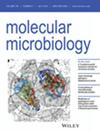Protein Homeostasis Impairment Alters Phenotypic Heterogeneity of Biofilm Communities
IF 2.6
2区 生物学
Q3 BIOCHEMISTRY & MOLECULAR BIOLOGY
引用次数: 0
Abstract
Biofilms are highly organized, cooperating communities of microorganisms encased in a self-produced extracellular matrix, providing resilience against external stress such as antimicrobial agents and host defenses. A hallmark of biofilms is their phenotypic heterogeneity, which enhances the overall growth and survival of the community. In this study, we demonstrate that removing the dnaK and tig genes encoding the core molecular chaperones DnaK (Hsp70 homolog) and Trigger factor disrupted protein homeostasis in Bacillus subtilis and resulted in the formation of an extremely mucoid biofilm with aberrant architecture, compromised structural integrity, and altered phenotypic heterogeneity. These changes include a large reduction in the motile subpopulation and an overrepresentation of matrix producers and endospores. Overproduction of poly-γ-glutamic acid contributed crucially to the mucoid phenotype and aberrant biofilm architecture. Homeostasis impairment, triggered by elevated temperatures, in wild-type cells led to mucoid and aberrant biofilm phenotypes similar to those observed in strains lacking both dnaK and tig. Our findings show that disruption of protein homeostasis, whether due to the absence of molecular chaperones or because of environmental factors, severely changes biofilm features.

蛋白质稳态损害改变生物膜群落表型异质性
生物膜是一种高度组织化、相互合作的微生物群落,它被包裹在一种自产的细胞外基质中,提供抗外部压力(如抗菌剂和宿主防御)的弹性。生物膜的一个特点是它们的表型异质性,这促进了群落的整体生长和生存。在这项研究中,我们证明了去除编码核心分子伴侣dnaK (Hsp70同源物)和触发因子的dnaK和tig基因会破坏枯草芽孢杆菌的蛋白质稳态,并导致形成具有异常结构,结构完整性受损和表型异质性改变的极其粘液的生物膜。这些变化包括运动亚群的大量减少和基质生产者和内生孢子的过度代表。聚γ-谷氨酸的过量产生对粘液样表型和异常生物膜结构起着至关重要的作用。在野生型细胞中,温度升高引发的稳态损伤导致黏液和异常的生物膜表型类似于在缺乏dnaK和tig的菌株中观察到的表型。我们的研究结果表明,无论是由于缺乏分子伴侣还是由于环境因素,蛋白质稳态的破坏都会严重改变生物膜的特征。
本文章由计算机程序翻译,如有差异,请以英文原文为准。
求助全文
约1分钟内获得全文
求助全文
来源期刊

Molecular Microbiology
生物-生化与分子生物学
CiteScore
7.20
自引率
5.60%
发文量
132
审稿时长
1.7 months
期刊介绍:
Molecular Microbiology, the leading primary journal in the microbial sciences, publishes molecular studies of Bacteria, Archaea, eukaryotic microorganisms, and their viruses.
Research papers should lead to a deeper understanding of the molecular principles underlying basic physiological processes or mechanisms. Appropriate topics include gene expression and regulation, pathogenicity and virulence, physiology and metabolism, synthesis of macromolecules (proteins, nucleic acids, lipids, polysaccharides, etc), cell biology and subcellular organization, membrane biogenesis and function, traffic and transport, cell-cell communication and signalling pathways, evolution and gene transfer. Articles focused on host responses (cellular or immunological) to pathogens or on microbial ecology should be directed to our sister journals Cellular Microbiology and Environmental Microbiology, respectively.
 求助内容:
求助内容: 应助结果提醒方式:
应助结果提醒方式:


